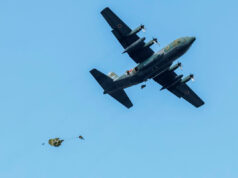The UK is examining sensor augmentation of the P-8 Poseidon to make it a suitable replacement for the Sentinel surveillance aircraft.
The information comes to light in a response to a written parliamentary question asked by Kevan Jones, MP for North Durham:
“To ask the Secretary of State for Defence, whether his Department plans to procure a new platform to enable the RAF to maintain its wide-area surveillance capability after the Sentinel R1 fleet is retired in 2021.”
Answered by Harriett Baldwin, Under Secretary of State for Defence Procurement:
“Work is on-going in the Ministry of Defence, led by Joint Forces Command, to determine the detailed requirements underpinning any future overland capability programme. A number of space-based, manned and unmanned aircraft solutions, including the development of a sensor for integration onto P-8A, are being explored as part of this work.”
Last year we reported that the UK is looking to improve the overland surveillance capability of the P-8 Poseidon aircraft it intends to purchase. A parliamentary question asked at the time by Kevan Jones shed light on this:
“To ask the Secretary of State for Defence, what future ground surveillance capabilities his Department plans to develop for the P-8 Poseidon programme.”
The reply from Philip Dunne, then Minister for Defence Procurement, read:
“The Ministry of Defence expects the P-8 Poseidon to be principally used in the Maritime Patrol Aircraft role, although it does have a limited overland surveillance capability.
We will be examining options to improve its overland capability but no plans are yet in place and no decisions have yet been taken.”
In 2010, Boeing proposed to replace the US Air Force’s Northrop Grumman E-8 Joint STARS fleet with a modified P-8 at the same cost Northrop Grumman proposed for re-engining and upgrading the E-8s. The proposed P-8 Airborne Ground Surveillance would integrate an AESA radar, and have ground moving target indicator and synthetic aperture radar capabilities.
The history of the aircraft dates back to June 2004, when the US Navy announced the selection of the Boeing multimission maritime aircraft, 737 MMA, and awarded a contract to Boeing for the system development and demonstration phase of the programme for the US Navy’s next-generation maritime surveillance aircraft.
Sentinel is a unique capability in Europe but one of the aircraft is being cut in order to save money. Earlier concerns centred around plans that the fleet would leave service entirely next year but a push to extend the service of the aircraft to 2021 seems to have been successful.
The Sentinel is an airborne battlefield and ground surveillance aircraft based on the Bombardier Global Express ultra long range business jet and serves a role similar to JSTARS with the RAF, the jet was adapted by Raytheon to meet the RAF’s requirements.













OK, this would make a lot of sense if the end result was maybe to divert funding from replacing the 4 Sentinel to developing the ground sensor package and increasing the size of the P-8A fleet by a few airframes but I’m afraid that I see this as leading up to another stealth cut. Develop the ground sensor but leave the P-8A fleet at 9 but now even more over-stretched and under-resourced because the fleet needs to not only fulfill its MPA role but also act as the tiniest plug for the capability gap of the lost Sentinels.
It looks as though this is the way it is heading Julian.
Another 7-9 would be great and get us to a critical volume, assume that by standardising we would save more money as well.
Another missed opportunity and lack of vision.
Yes but that would mean another 2 wing commanders !
…..and they would probably command a flight each!
LOL.
9 is barely enough as it is, this is just another stealth cut, unless they intend to use UAVs to help fill both maritime and overland surveillance roles.
If we are going to use Poseidon with an underwing or under fuselage sensor pod for ground movement surveillance we will need more than 9 aircraft.
9 aircraft ordered already really are the minimum needed to give a basic level of MPA functionality. Certainly not enough to replace Sentinel as well. We would need 7-9 more aircraft to do this. Although agree with the notion, it makes a lot of sense for commonality of airframe, maintenance and aircrew training.
will not happen but the wing commanders will.